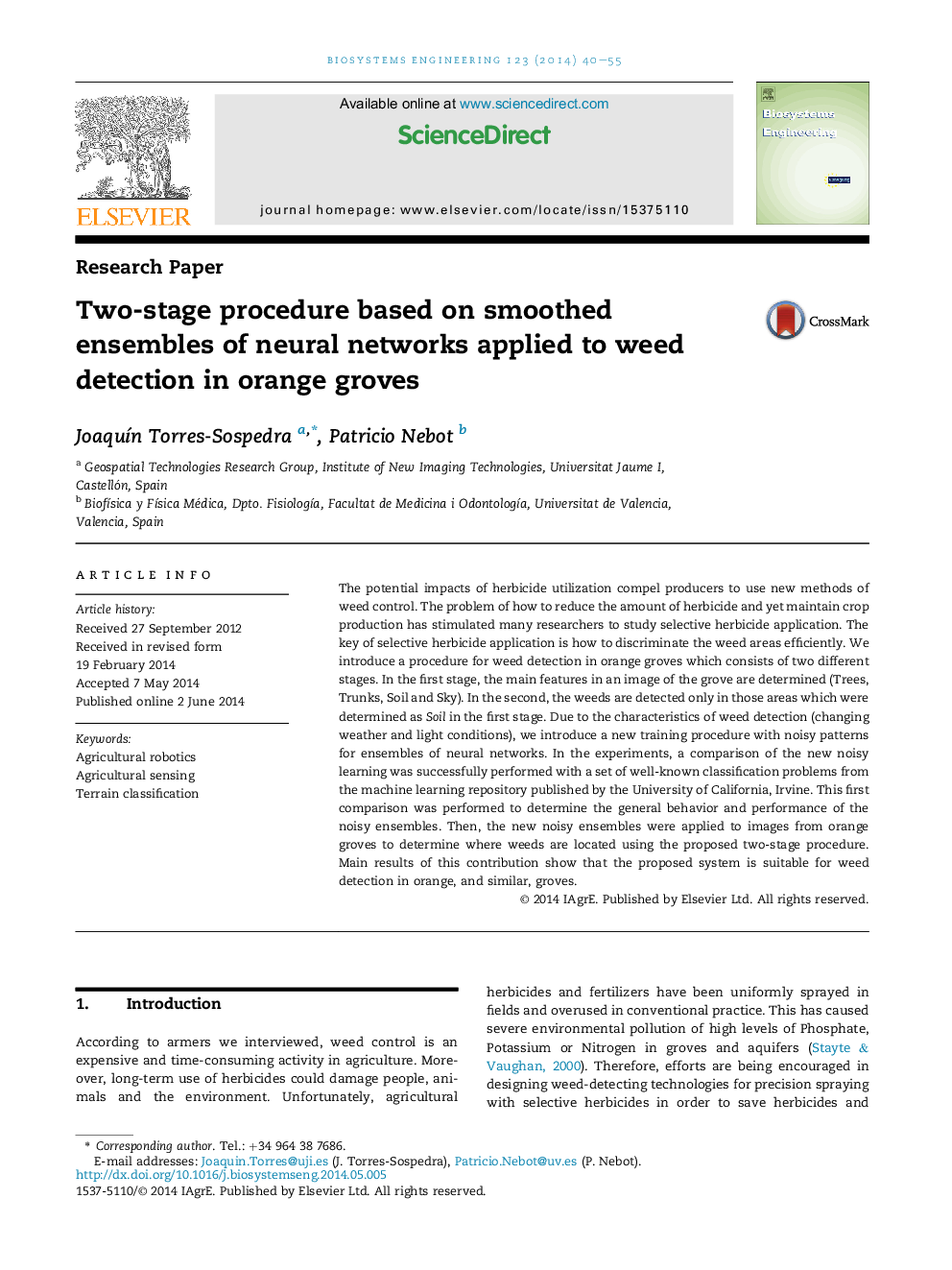| کد مقاله | کد نشریه | سال انتشار | مقاله انگلیسی | نسخه تمام متن |
|---|---|---|---|---|
| 1711195 | 1519538 | 2014 | 16 صفحه PDF | دانلود رایگان |
عنوان انگلیسی مقاله ISI
Two-stage procedure based on smoothed ensembles of neural networks applied to weed detection in orange groves
ترجمه فارسی عنوان
روش دو مرحله ای بر اساس مجموعه های نرم افزاری شبکه های عصبی کاربردی برای تشخیص علف های هرز در گیاهان نارنجی
دانلود مقاله + سفارش ترجمه
دانلود مقاله ISI انگلیسی
رایگان برای ایرانیان
کلمات کلیدی
رباتیک کشاورزی، سنجش کشاورزی، طبقه بندی زمین
ترجمه چکیده
اثرات بالقوه استفاده از علف کش ها تولید کنندگان را مجبور به استفاده از روش های جدید کنترل علف های هرز می کند. مشکل چگونگی کاهش میزان علف کش ها و در عین حال حفظ تولید محصول باعث تحریک بسیاری از محققان به مطالعه کاربرد علف کش های انتخابی شده است. کلید استفاده از علف کش های انتخابی این است که چگونه مناطق علف های هرز را به صورت موثر تشخیص دهند. ما یک روش برای شناسایی علف های هرز در گیاهان نارنجی که از دو مرحله مختلف تشکیل شده است معرفی می کنیم. در مرحله اول، ویژگی های اصلی در یک تصویر از باغچه تعیین می شود (درختان، تنه، خاک و آسمان). در مرحله دوم، علف های هرز تنها در مناطقی تشخیص داده می شوند که به عنوان خاک در مرحله اول تعیین می شوند. با توجه به ویژگی های تشخیص علف های هرز (تغییر شرایط آب و هوایی و نور)، یک روش آموزش جدید با الگوهای پر سر و صدا برای مجموعه های شبکه های عصبی معرفی می کنیم. در آزمایشات، مقایسه ای از یادگیری پر سر و صدایی با موفقیت با مجموعه ای از مشکلات طبقه بندی شناخته شده از مخزن یادگیری ماشین منتشر شده توسط دانشگاه کالیفرنیا ایروین انجام شد. این اولین مقایسه برای تعیین رفتار عمومی و عملکرد گروه های پر سر و صدا انجام شد. سپس، گروه های پر سر و صدایی جدید برای تصاویری از درختان نارنجی به منظور تعیین وجود علف های هرز با استفاده از روش پیشنهادی دو مرحلهای اعمال شدند. نتایج اصلی این سهم نشان می دهد که سیستم پیشنهادی مناسب برای تشخیص علف های هرز در پرتقال و گیاهان مشابه است.
موضوعات مرتبط
مهندسی و علوم پایه
سایر رشته های مهندسی
کنترل و سیستم های مهندسی
چکیده انگلیسی
The potential impacts of herbicide utilization compel producers to use new methods of weed control. The problem of how to reduce the amount of herbicide and yet maintain crop production has stimulated many researchers to study selective herbicide application. The key of selective herbicide application is how to discriminate the weed areas efficiently. We introduce a procedure for weed detection in orange groves which consists of two different stages. In the first stage, the main features in an image of the grove are determined (Trees, Trunks, Soil and Sky). In the second, the weeds are detected only in those areas which were determined as Soil in the first stage. Due to the characteristics of weed detection (changing weather and light conditions), we introduce a new training procedure with noisy patterns for ensembles of neural networks. In the experiments, a comparison of the new noisy learning was successfully performed with a set of well-known classification problems from the machine learning repository published by the University of California, Irvine. This first comparison was performed to determine the general behavior and performance of the noisy ensembles. Then, the new noisy ensembles were applied to images from orange groves to determine where weeds are located using the proposed two-stage procedure. Main results of this contribution show that the proposed system is suitable for weed detection in orange, and similar, groves.
ناشر
Database: Elsevier - ScienceDirect (ساینس دایرکت)
Journal: Biosystems Engineering - Volume 123, July 2014, Pages 40-55
Journal: Biosystems Engineering - Volume 123, July 2014, Pages 40-55
نویسندگان
JoaquÃn Torres-Sospedra, Patricio Nebot,
